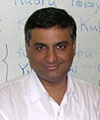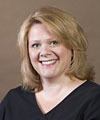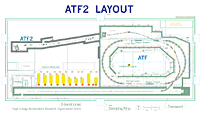Developing Accelerators
in India

Srinivas
Krishnagopal |
Last week, Srinivas Krishnagopal of the Centre for Advanced Technology in Indore, India, visited KEK to have discussions with the researchers on ATF, STF and J-PARC. "These facilities look extremely good", he said. "J-PARC is a very big project, and it appears that it will be built efficiently on time. The operation of KEKB is also going very well. I am told that KEK is inviting international collaborators for these facilities, especially from Asian countries. I’m sure the accelerator community in India would look forward to such collaborations."
Read more...
--Youhei Morita
|
 |
|
|
 |
Meet Maxine

Maxine Hronek |
Earlier this fall, the GDE acquired its fiftieth member, Maxine Hronek. As the GDE Office Administrator, Hronek will take care of the day to day activities of running the office, which is now under construction on the thirteenth floor of Wilson Hall at Fermilab. She is also responsible for the arranging travel, financial reporting and assisting Director Barry Barish with the requests and challenges of the GDE.
“I took this position because it is a great opportunity to use all the skills I have acquired from my different roles at Fermilab over the years”, Hronek said. “I like being part of a project from the beginning and seeing it come to fruition. I particularly like the international aspect of the ILC, which is a new – and very appealing -- challenge for me.”
Read more...
--Elizabeth Clements
|
 |
|
|
 |
Upcoming meetings, conferences, workshops
CARE 05
CERN, Switzerland, 23-25 November 2005
Mini Workshop on Design
for High Availability
Hotel CARAT at Grömitz (located at the Baltic
Sea), 1-2 December 2005
ILC Spanish Meeting
Gandia, Spain, 1-3 December 2005
TESLA Technology Collaboration Meeting
Frascati, Italy, 5-6 December 2005
GDE Meeting
Frascati, Italy, 7-9 December 2005
American Linear Collider Physics Group - Detector Simulation Workshop
Boulder, Colorado, U.S.A., 9-11 January 2006
2006 LCWS 2006
Bangalore, India, 9-15 March 2006
International School for Linear Colliders
Sokendai, Graduate School for Advanced Studies
Hayama, Japan, 19-27 May 2006
|
|
 |
 |
|
|
 |
International
Collaboration on ATF

ATF-II is an extension of the ATF beamline, shown in gray structure. ATF-II will establish the beam position monitoring and control at the nanometer level. |
The Accelerator Test Facility (ATF) at KEK, which has been in operation since 1994, consists of a 1.3GeV electron linac driven by a multi-bunch capable electron gun, a 1.3 GeV damping ring and a beam extraction line. It has been serving as a unique test facility
for establishing the feasibility of producing and controlling the ultra-low emittance beam that is required for linear colliders.
Since last year, the development in the world landscape related to the linear collider has come to bring renewed interests in ATF. An obvious area of research is to respond to the demanding performance requirements for the ILC damping rings, including the development of very fast kickers. Yet another interest exists in exploiting the ultra-low emittance beam of ATF for studying the issues related to the final focus system at ILC.
Simulation studies indicate that by applying the beam optics design, which would be used at the ILC final focus system (FFS), the ATF beam can be transversally focused down to approximately 40 nanometer in its extended beam extraction line called ATF2. This exercise, studies tell, would provide the scientists with a wealth of practical experience and detailed information on how to "do it right" with the real-life ILC FFS.
Read more...
--T.Tauchi and J.Urakawa
|
 |
|
|
 |
From Fermilab Today
3 November 2005
Community Group Discusses International Linear Collider
Members of the Fermilab Community Task Force on Public Participation met Tuesday evening to discuss issues related to the proposed International Linear Collider, and its potential impact on Fermilab and the community. Doug Sarno of The Perspectives Group, the Alexandria, Va. consulting firm that guided the CTF efforts throughout 2004, is acting as facilitator.
"There are many social issues to discuss, as we work on how to develop a really robust plan for public participation with the ILC process," Sarno said at the group's organizational meeting, held Tuesday night, November 1, in Wilson Hall.
Read more...
From FYI - The American Institute of Physics Bulletin of Science Policy News
21 November 2005
Boehlert Demands A Plan for ITER Financing
Rep. Sherwood Boehlert (R-NY), the chairman of the House Science Committee, has been vocal over his concern that the U.S.'s participation in ITER, the international fusion research project, will be jeopardized unless plans are made to restructure the domestic fusion program to pay for the international effort.
Read more...
|
|
 |
 |
|
|
 |
Damping Ring Recommendation
Reaching the luminosity goals of the ILC will be an enormous challenge. It will require producing nanometer scale beam spots at the collision point and a crucial element in achieving this will be to “damp” the beams that come from the electron and positron sources to have ultra-low emittance (a measure of the non parallelism). Once achieved, the beams must then be transported to the collision points without significant emittance growth or uncontrolled beam jitter (a problem I will discuss in a later column).
The scheme for achieving such low emittance is to use the effects of synchrotron radiation on the particles transported through damping rings, and this is then combined with acceleration in RF cavities to produce sufficiently reduced emittance beams. A particular challenge for the ILC damping rings is that the long ~1 msec beam pulse containing up to 3000 bunches infers a long damping ring length. The actual length of the rings is determined by the bandwidth of the input and extraction systems.
The TESLA design employed a 17km “dogbone” damping ring that shared the same tunnel as the main linac (to save money) and had turnarounds that made the shape of the damping ring look something like a dog bone. Recent developments on fast kicker magnets have allowed us to consider alternative shorter length damping rings of 3 km and 6 km that can be external to the main linac tunnel. Although not a consideration in the present study and recommendation, this might allow consideration of the use of existing rings for potential sites at some of our accelerator laboratories.
The ILC Damping Ring Working Group is led by Jie Gao (IHEP), S. Guidicci (INFN) and A. Wolski (LBNL). The comparison of different alternatives is a very complex problem with different trade-offs for different possible damping ring configurations. Our ILC damping ring working group has been working very systematically to analyze the problem and compare alternative designs. Comparisons of costs and the magnitude of various limiting effects have been analyzed using different lattice configurations, especially for the 6 km external ring and the 17 km dogbone damping ring.
Read more...
--Barry Barish
Director's Corner Archive
|
 |
|
|
 |
Early Edition
of NewsLine This Week
Due to the Thanksgiving Holiday in the United States this Thursday, the GDE
Communicators are sending you an early edition of ILC NewsLine this week.
The publication will return to its normal schedule next week.
"Strawman" Baseline Released
The Baseline Configuration Document Executive Committee met 17-18 and reviewed all the inputs from the working groups, the reviews of those reports and a set of special white papers on critical issues. As a result, they established a "Strawman" Baseline to serve as the basis of discussions at the Frascati GDE meeting on 7-9 December. The "Strawman" BCD is now available online.
Read more...
|
|

